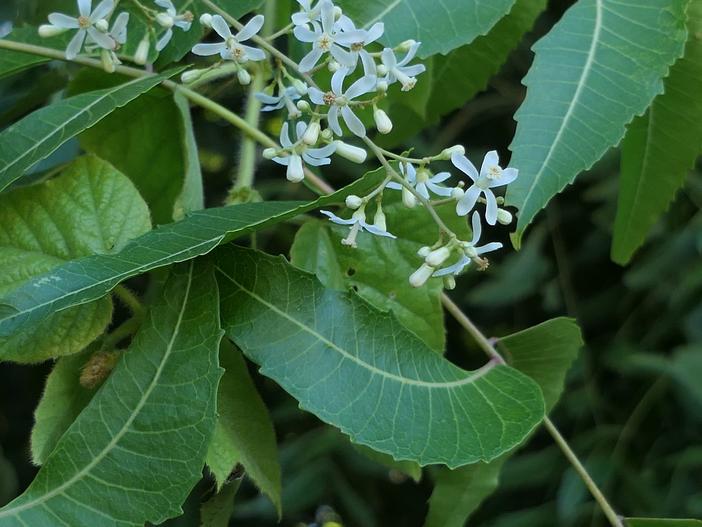Neem
(Azadirachta indica)
Neem (Azadirachta indica)
/
/

Dinesh Valke
CC BY-SA 2.0
Image By:
Dinesh Valke
Recorded By:
Copyright:
CC BY-SA 2.0
Copyright Notice:
Photo by: Dinesh Valke | License Type: CC BY-SA 2.0 | License URL: https://creativecommons.org/licenses/by-sa/2.0/ | Uploader: Dinesh Valke | Publisher: Flickr










































































Estimated Native Range
Summary
Azadirachta indica, commonly known as Neem, is a deciduous tree originally found in dry deciduous forests, scrub forests, and semi-arid regions in South and Southeast Asia. It is a fast-growing species that can reach heights of 15–20 meters (49–66 ft) with a wide, spreading branch structure. The crown is fairly dense, roundish, and may reach a diameter of 20–25 meters (66–82 ft). Neem trees produce white, fragrant flowers in drooping axillary panicles up to 25 cm (10 in) long, with inflorescences branching up to the third degree and bearing 250 to 300 flowers. The flowering season is in the spring, and the flowers are considered moderately showy. Neem is also known for its hardy nature, being particularly drought-resistant.
Neem trees are valued for their medicinal properties, with various parts of the plant used in traditional medicine. The tree is also planted for shade, as a windbreak, and for its ability to improve soil fertility through nitrogen fixation. It is adaptable to a range of soil types, though it thrives best in well-drained deep and sandy soils. Neem requires full sun to part shade and moderate water, making it relatively easy to maintain. However, it is potentially invasive outside its native range, so gardeners should check local regulations before planting. Neem’s wood is also used for timber, and its seeds are the source of neem oil, widely used in cosmetics and as a natural insecticide.CC BY-SA 4.0
Neem trees are valued for their medicinal properties, with various parts of the plant used in traditional medicine. The tree is also planted for shade, as a windbreak, and for its ability to improve soil fertility through nitrogen fixation. It is adaptable to a range of soil types, though it thrives best in well-drained deep and sandy soils. Neem requires full sun to part shade and moderate water, making it relatively easy to maintain. However, it is potentially invasive outside its native range, so gardeners should check local regulations before planting. Neem’s wood is also used for timber, and its seeds are the source of neem oil, widely used in cosmetics and as a natural insecticide.CC BY-SA 4.0
Plant Description
- Plant Type: Tree
- Height: 50-75 feet
- Width: 50-75 feet
- Growth Rate: Rapid
- Flower Color: White
- Flowering Season: Spring
- Leaf Retention: Deciduous
Growth Requirements
- Sun: Full Sun, Part Shade
- Water: Low, Medium
- Drainage: Medium, Fast
Common Uses
Drought Tolerant, Edible*Disclaimer: Easyscape's listed plant edibility is for informational use. Always verify the safety and proper identification of any plant before consumption., Erosion Control, Fragrant
Natural Habitat
Originally found in dry deciduous forests, scrub forests, and semi-arid regions in South and Southeast Asia
Other Names
Common Names: Margosa, Neem Tree, Niembaum, Indian-Lilac, Indian Lilac
Scientific Names: , Azadirachta indica, Melia azadirachta, Antelaea azadirachta, Melia indica, Azadirachta indica var. siamensis, Azadirachta indica var. minor, Antelaea canescens, Azadirachta indica subsp. vartakii, Azedarach fraxinifolia
GBIF Accepted Name: Azadirachta indica A.Juss.